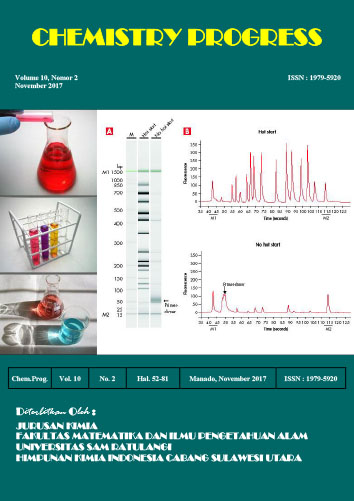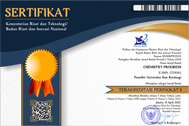KARAKTERISASI DAN POTENSI ANTIOKSIDAN DARI KULIT LUAR UBI KAYU (Manihot utilissima)
DOI:
https://doi.org/10.35799/cp.10.2.2017.27747Abstract
ABSTRAK
Â
Penelitian ini bertujuan untuk mengetahui potensi antioksidan ekstrak etanol periderm (kulit luar) umbi kuning (PUK) dan putih (PUP) dari ubi kayu dalam penghambatan reaksi oksidasi in vitro homogenat jaringan tikus putih galur wistar, serta identifikasi senyawa fenolik yang terkandung dalam ekstrak. Efek inhibisi ditentukan menggunakan metode 2-thiobarbituric acid reactive substances (TBARS) dimana jaringan hati, jantung dan otak diesktrak hingga didapatkan homogenat kemudian dilakukan pengujian inhibisi menggunakan TBA. Kandungan senyawa fenolik pada PUK dan PUP diidentifikasi gugus fungsionalnya menggunakan spektrofotometer inframerah dan spektrofotometer uv-vis. Ekstrak etanol periderm umbi kuning menunjukkan adanya potensi inhibisi sebesar 37,13, 56,0, dan 21,73% pada hati, jantung, dan otak sedangkan ubi putih menunjukkan potensi inhibisi sebesar 52,63, 65,33, dan 27,33%. Hasil identifikasi dengan spektrofotometer inframerah menunjukkan adanya gugus fenolik pada PUK dan PUP, ditandai dengan puncak pada 3399, 2926, 1251, 1611, 1517, dan 1452 cm-1 pada PUK serta 3400, 2920, 1054, 1611, 1282, 1517, dan 1452 cm-1 pada PUP. Adapun hasil serapan ekstrak PUK dan PUP pada spektrofotometer uv-vis yang menunjukkan puncak maksimum pada 245 dan 290 nm yang menunjukkan adanya kandungan senyawa fenolik.
Â
Kata kunci: Periderm, ubi kuning, ubi putih, fenolik, homogenat, TBARS, spektrofotometri infra red
  Â
Â
ABSTRACT
Â
The aims of this research were to analyze the potential of ethanol extract of periderm of yellow cassava (PYC) and periderm of white cassava (PWC) in inhibiting in vitro oxidation of tissue homogenates of wistar rat and to identify phenolic compound contained in the extract. Inhibition effect was determined using 2-thiobarbituric acid reactive substances (TBARS) method by extracting liver, heart and brain to obtain homogenates and then evaluated with TBA. The functional group of phenolic compound in PYC and PWC was identified by infrared spectrophotometry. The results indicate that ethanol extract of PYC could inhibit oxidation by 37.13, 56.0 and 21.73% in liver, heart, and brain while PWC could inhibit oxidation by 52.63, 65.33, and 27.33% in the same organs. The identification of functional group with infrared spectrophotometer showed the presence of phenolic group with absorption peak 3399, 2926, 1251, 1611, 1517, and 1452 cm-1 in PYC and 3400, 2920, 1054, 1611, 1282, 1517, and 1452 cm-1 in PWC. The uv-vis spectrophotometer for PYC and PWC showed the peaks in 245 and 290 nm which indicate the presence of phenolic compound.
Â
Keywords: periderm, yellow cassava, white cassava, phenolic, homogenate, TBARS, infrared spectrophotometer,
UV-vis spectrophotometer












